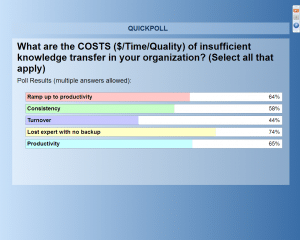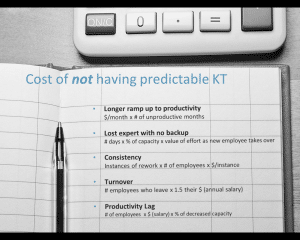If you’ve been following this blog you know that over the last few years we’ve added many new ideas and systems to our knowledge transfer work. We started with the Knowledge Transfer Workshop (KTW), then added the Skill Development Plan (SDP) and the Knowledge Silo Matrix (KSM), followed by pilot knowledge transfer implementations for teams within client organizations (see our KT case studies). We added change management support, manager training, and the development of internal process owners (KTPOs) so that our clients could take over from us and maintain their knowledge transfer systems over the long term. We developed scorecards to track progress and root out obstacles, and we introduced executive level metrics and dashboard reporting to show value and maintain momentum. Earlier this year we demonstrated how to connect knowledge transfer to an organization’s business strategy, a necessary step when rolling out knowledge transfer at the enterprise level. I summarized this strategic thinking in a blog series and in our Knowledge Transfer Strategy white paper. Most recently, I’ve been introducing into the knowledge transfer conversation metrics and clear ways to discuss the very real costs of having insufficient knowledge transfer at your organization.
Last week during a webinar I gave on “The Power of Knowledge Transfer,” cosponsored our friends at Career Partners International, we polled the more than 300 attendees about how they most often experienced the costs of a lack of or insufficient knowledge transfer.
 Figure 1. Poll results showing typical costs associated with poor knowledge transfer as experienced by the more than 300 webinar participants. (From Steve Trautman’s Dec. 12 webinar and panel discussion on ‘The Power of Knowledge Transfer,’ cosponsored with CPI.)
Figure 1. Poll results showing typical costs associated with poor knowledge transfer as experienced by the more than 300 webinar participants. (From Steve Trautman’s Dec. 12 webinar and panel discussion on ‘The Power of Knowledge Transfer,’ cosponsored with CPI.)
 Figure 2. These simple equations can help you calculate the costs of insufficient knowledge transfer at your organization.
Figure 2. These simple equations can help you calculate the costs of insufficient knowledge transfer at your organization.Figure 1 shows a screen capture of the results. Three-fourths of those responding said that a “Lost Expert with No Back Up” was their greatest cost, followed by 2/3 responding that overall losses in “Productivity” and slow “Ramp Up to Productivity” of new hires and transfers were the next most common costs. Later in the webinar we provided cost calculators [Figure 2]—simple equations that managers can use to assess their cost-to-benefit ratio and make the case for implementing structured knowledge transfer in their organization.
The response to the webinar has been very exciting, and soon we’ll be posting an audio of the session for those who missed it.
So please, spread the word about the value of knowledge transfer, the wealth of tools available to solve a business’s talent challenges, and the ways to put a dollar value to the risks of doing this KT work poorly. We’re definitely on to something here and look forward to helping more organizations reduce their talent risks and prepare for the future.
